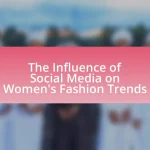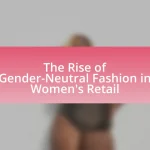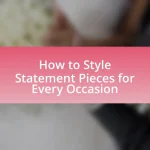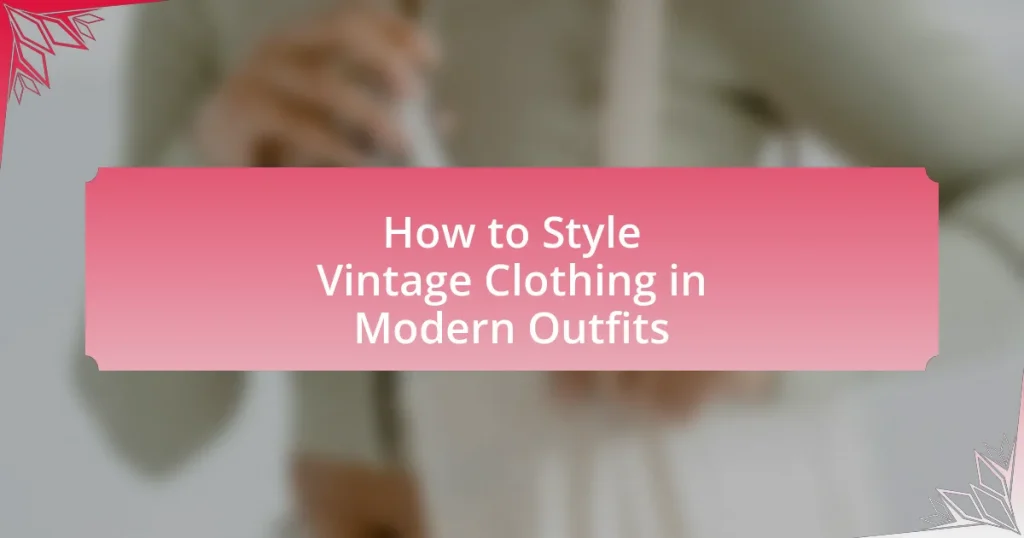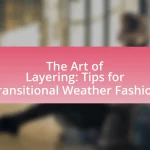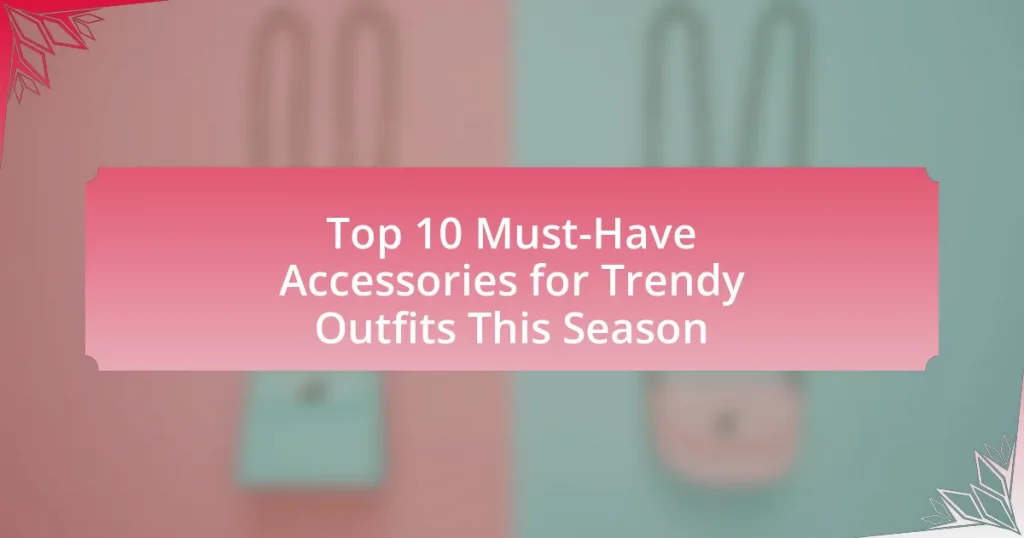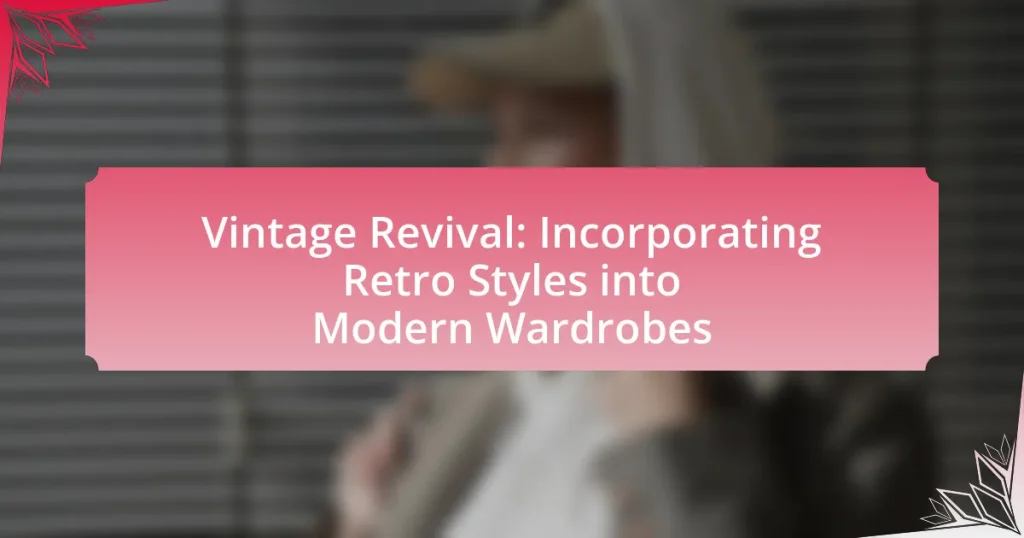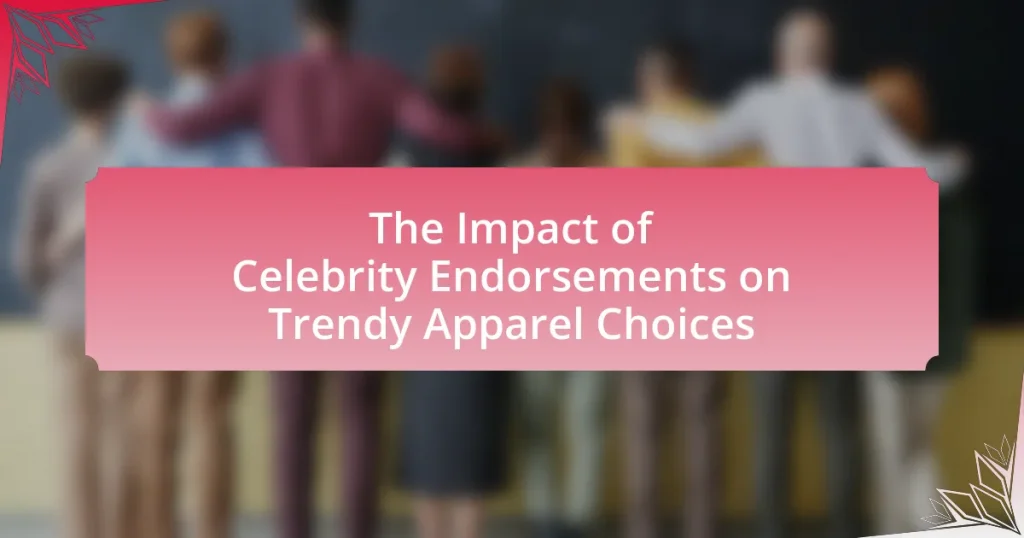The article focuses on the significance of styling vintage clothing within modern outfits, highlighting its role in personal expression and sustainability in fashion. It explores how vintage pieces influence contemporary trends, their key characteristics, and the timeless nature of such garments. The article also discusses the benefits of incorporating vintage items into modern wardrobes, including promoting individuality and reducing environmental impact. Additionally, it provides practical tips for effectively mixing vintage and modern styles, selecting complementary colors and patterns, and avoiding common styling mistakes.
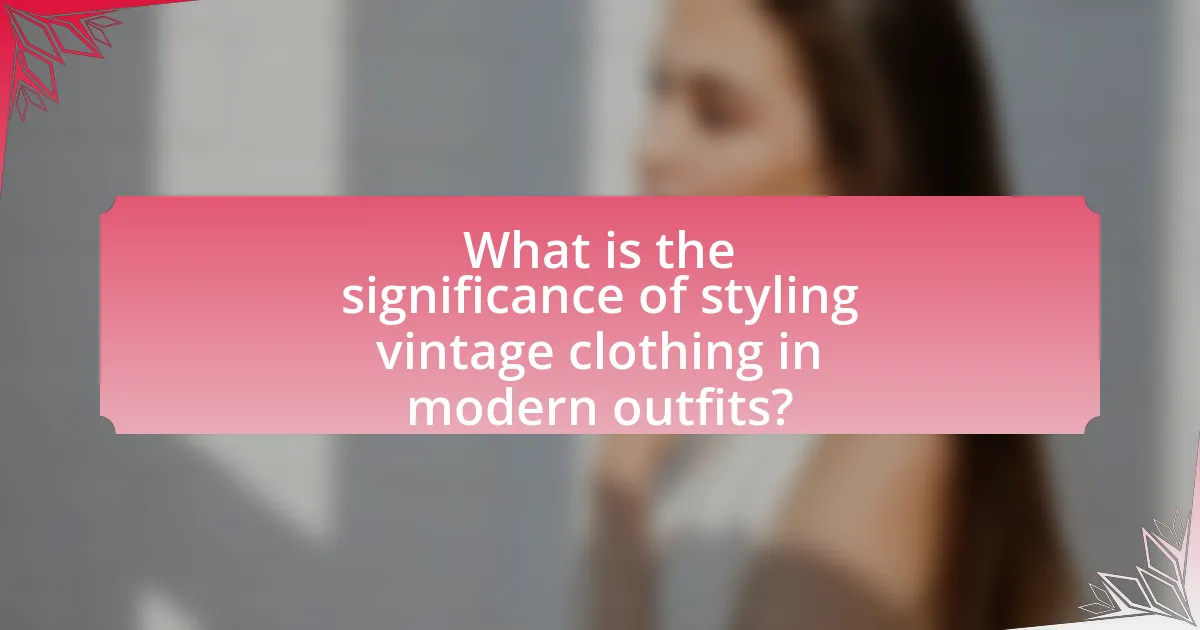
What is the significance of styling vintage clothing in modern outfits?
Styling vintage clothing in modern outfits is significant because it allows individuals to express their unique identity while promoting sustainability in fashion. Vintage pieces often carry historical value and distinct aesthetics that differentiate them from contemporary mass-produced clothing. By incorporating vintage items, wearers can create personalized looks that reflect their individuality and creativity. Additionally, the fashion industry is increasingly recognizing the environmental impact of fast fashion; thus, choosing vintage clothing contributes to reducing waste and encourages a more sustainable approach to style. This practice not only preserves fashion history but also supports the circular economy by extending the life cycle of garments.
How does vintage clothing influence contemporary fashion trends?
Vintage clothing significantly influences contemporary fashion trends by reintroducing styles, patterns, and silhouettes from past decades into modern wardrobes. Designers often draw inspiration from vintage aesthetics, leading to the revival of elements such as high-waisted jeans, oversized blazers, and retro prints. For instance, the resurgence of 90s fashion in recent years, characterized by items like crop tops and mom jeans, demonstrates how vintage styles can shape current trends. Additionally, the popularity of thrift shopping and sustainable fashion has made vintage clothing a staple in contemporary fashion, encouraging consumers to embrace unique, one-of-a-kind pieces that reflect personal style while also promoting environmental consciousness.
What are the key characteristics of vintage clothing?
Vintage clothing is defined by its age, typically being at least 20 years old, and its unique style that reflects the fashion trends of a specific era. Key characteristics include distinctive designs, high-quality materials, and craftsmanship that often surpasses contemporary mass-produced garments. For instance, clothing from the 1960s may feature bold patterns and colors, while 1980s pieces often showcase oversized silhouettes and vibrant hues. Additionally, vintage clothing often carries historical significance, representing cultural movements or fashion revolutions, such as the rise of punk fashion in the 1970s. These elements contribute to the appeal and value of vintage items in modern fashion contexts.
Why is vintage clothing considered timeless?
Vintage clothing is considered timeless because it embodies unique styles and craftsmanship that transcend fleeting fashion trends. The enduring appeal of vintage garments lies in their distinctive designs, high-quality materials, and the nostalgia they evoke, which resonate with consumers seeking individuality and authenticity in their wardrobe. Historical context supports this notion; for instance, styles from the 1920s to the 1980s continue to influence contemporary fashion, demonstrating that certain aesthetics remain relevant across generations. This blend of quality, uniqueness, and cultural significance solidifies vintage clothing’s status as a lasting staple in fashion.
What are the benefits of incorporating vintage pieces into modern outfits?
Incorporating vintage pieces into modern outfits enhances personal style and promotes sustainability. Vintage items often feature unique designs and high-quality materials that are not commonly found in contemporary fashion, allowing individuals to express their individuality and stand out. Additionally, using vintage clothing reduces waste and the demand for fast fashion, contributing to environmental conservation. According to a study by the Ellen MacArthur Foundation, extending the life of clothing by just nine months can reduce carbon, water, and waste footprints by 20-30%. This evidence supports the notion that integrating vintage pieces not only enriches personal aesthetics but also aligns with eco-friendly practices.
How does vintage clothing promote individuality in fashion?
Vintage clothing promotes individuality in fashion by offering unique styles that are not commonly found in contemporary collections. Each vintage piece often carries a distinct history and aesthetic, allowing wearers to express their personal identity and creativity. For instance, clothing from specific decades, such as the 1960s or 1980s, features unique cuts, patterns, and colors that stand out in a sea of modern fast fashion. This distinctiveness enables individuals to curate outfits that reflect their personal tastes and differentiate them from mainstream fashion trends. Additionally, the limited availability of vintage items means that individuals are less likely to encounter others wearing the same pieces, further enhancing their sense of uniqueness in style.
What environmental benefits come from wearing vintage clothing?
Wearing vintage clothing significantly reduces environmental impact by promoting sustainability through the reuse of garments. This practice minimizes waste, as it extends the lifecycle of clothing that would otherwise contribute to landfills; in fact, the fashion industry is responsible for 92 million tons of waste annually. Additionally, vintage clothing production typically requires fewer resources compared to new clothing manufacturing, which involves water, energy, and raw materials. By choosing vintage, consumers help decrease the demand for fast fashion, which is linked to high carbon emissions and pollution.
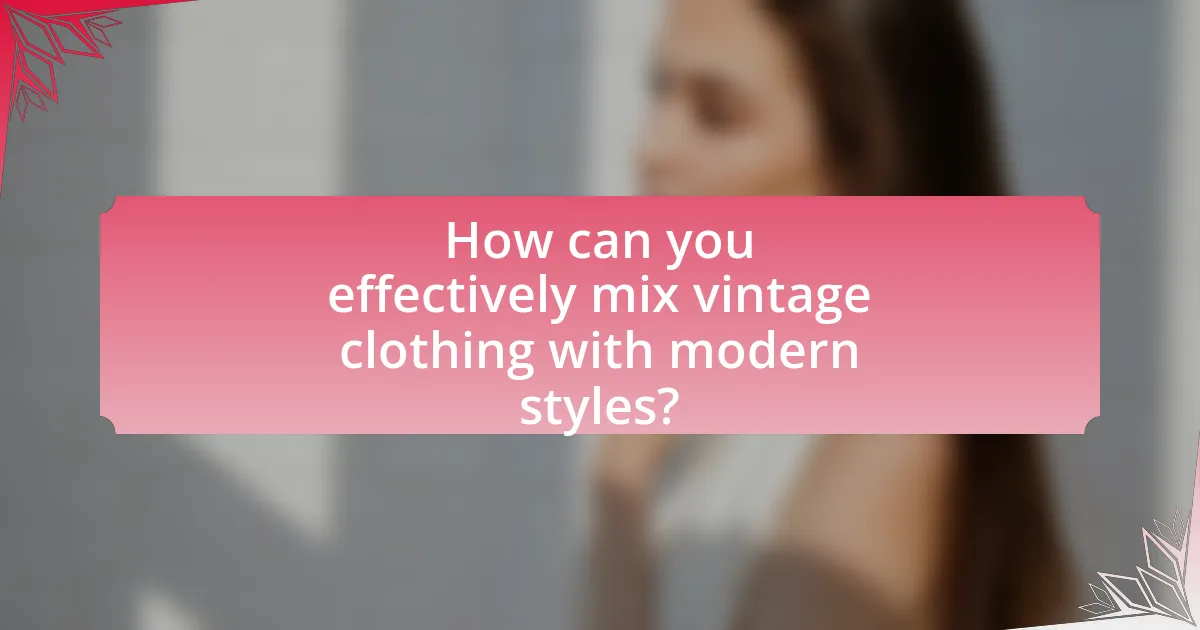
How can you effectively mix vintage clothing with modern styles?
To effectively mix vintage clothing with modern styles, select one or two vintage pieces and pair them with contemporary items to create a balanced look. For instance, a vintage dress can be complemented with modern accessories like a sleek belt or trendy shoes, which helps to bridge the gap between eras. This approach is supported by fashion experts who emphasize the importance of contrast; combining the unique textures and patterns of vintage clothing with the clean lines and minimalism of modern fashion creates a visually appealing ensemble.
What are the best practices for pairing vintage and modern pieces?
The best practices for pairing vintage and modern pieces include selecting complementary colors, balancing proportions, and incorporating statement accessories. Complementary colors create visual harmony; for example, pairing a vintage floral dress with a modern solid-colored jacket enhances the overall look. Balancing proportions is crucial; a fitted modern top can be paired with a flowing vintage skirt to create a balanced silhouette. Additionally, using statement accessories, such as a vintage handbag with modern attire, can bridge the gap between styles and add character to the outfit. These practices ensure a cohesive and stylish appearance that respects both vintage and contemporary aesthetics.
How do you choose complementary colors and patterns?
To choose complementary colors and patterns, identify a color wheel and select colors that are opposite each other, such as blue and orange or red and green. This method is grounded in color theory, which states that complementary colors enhance each other when paired, creating visual interest. Additionally, when selecting patterns, ensure that one pattern is dominant while the other is subtle to maintain balance; for example, pairing a bold floral print with a small polka dot can create a harmonious look. This approach is supported by design principles that emphasize contrast and balance in visual compositions.
What accessories enhance a vintage-modern outfit combination?
Accessories that enhance a vintage-modern outfit combination include statement jewelry, retro handbags, and modern footwear. Statement jewelry, such as oversized earrings or layered necklaces, adds a bold touch that bridges the gap between vintage and contemporary styles. Retro handbags, like structured clutches or crossbody bags with vintage patterns, provide a nostalgic element while remaining functional. Modern footwear, such as sleek ankle boots or minimalist sneakers, can ground the outfit and offer comfort, ensuring that the overall look feels fresh and relevant. These accessories effectively blend the charm of vintage aesthetics with the practicality of modern fashion.
What common mistakes should be avoided when styling vintage clothing?
Common mistakes to avoid when styling vintage clothing include overloading on vintage pieces, which can create a dated look. Mixing too many eras can confuse the outfit’s aesthetic; instead, select one or two vintage items and pair them with modern pieces for balance. Additionally, neglecting proper fit is a frequent error; vintage clothing often has different sizing standards, so tailoring may be necessary to achieve a flattering silhouette. Lastly, failing to consider the occasion can lead to inappropriate styling; vintage clothing should be adapted to suit modern contexts, ensuring that the overall look is cohesive and suitable for the setting.
How can you prevent clashing styles between vintage and modern items?
To prevent clashing styles between vintage and modern items, focus on creating a cohesive color palette that harmonizes both styles. By selecting colors that complement each other, you can bridge the gap between the vintage and modern pieces, ensuring they work together rather than compete. For instance, if a vintage dress features muted tones, pairing it with modern accessories in similar shades can create a unified look. Additionally, incorporating one statement piece from each style can serve as a focal point, allowing the other items to support rather than clash with each other. This approach is supported by design principles that emphasize color theory and balance in fashion, which suggest that a well-coordinated color scheme enhances overall aesthetic appeal.
What should you consider regarding fit and silhouette?
When considering fit and silhouette in vintage clothing, prioritize how the garment contours to the body and its overall shape. A well-fitted piece enhances the wearer’s figure, while the silhouette defines the garment’s style, such as A-line, straight, or oversized. For instance, vintage dresses often feature defined waists and flared skirts, which can create an hourglass shape, appealing to modern aesthetics. Additionally, understanding the historical context of the silhouette can guide choices; for example, 1950s styles emphasize femininity, while 1970s styles may lean towards a more relaxed fit. This knowledge ensures that the vintage piece complements contemporary fashion trends effectively.
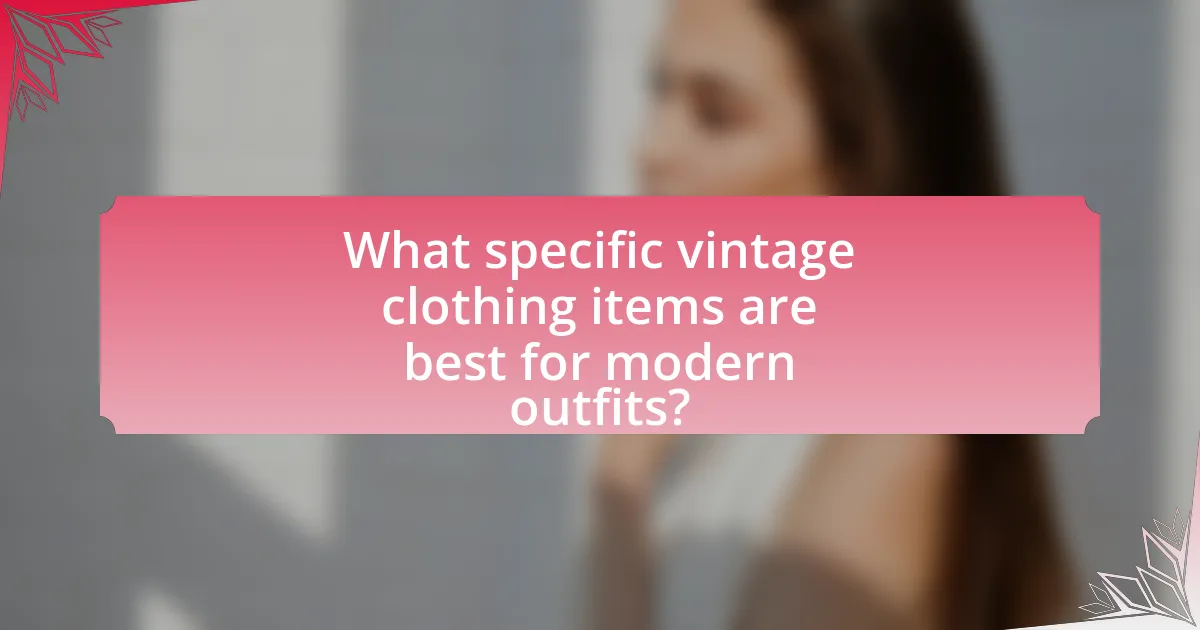
What specific vintage clothing items are best for modern outfits?
Specific vintage clothing items that are best for modern outfits include high-waisted jeans, oversized blazers, vintage band tees, and midi dresses. High-waisted jeans, popularized in the 1980s and 1990s, provide a flattering silhouette and can be paired with contemporary tops for a balanced look. Oversized blazers, a staple from the 1980s, add structure and sophistication to casual outfits. Vintage band tees, originating from the 1970s and 1980s, offer a nostalgic yet trendy vibe when styled with modern accessories. Midi dresses, which gained popularity in the 1960s, are versatile and can be dressed up or down, making them suitable for various occasions. These items not only reflect timeless fashion but also seamlessly integrate into current trends, enhancing modern wardrobes.
Which vintage clothing pieces are versatile for everyday wear?
Vintage denim jackets are versatile for everyday wear. They can be paired with various outfits, from casual t-shirts to dresses, making them suitable for multiple occasions. Additionally, vintage band t-shirts offer a relaxed style that complements jeans or shorts, while vintage high-waisted trousers provide a chic look that can be dressed up or down. These pieces are timeless and adaptable, allowing for easy integration into modern wardrobes.
How can a vintage blazer elevate a casual outfit?
A vintage blazer can elevate a casual outfit by adding sophistication and structure, transforming a simple look into a polished ensemble. The tailored fit and unique fabric patterns of vintage blazers often contrast with casual pieces like jeans or t-shirts, creating a visually appealing balance. Historical fashion trends show that blazers have been used since the 19th century to convey authority and style, making them a timeless addition to any wardrobe. This combination of classic design and modern casual wear enhances overall aesthetics, making the outfit more versatile for various occasions.
What role do vintage dresses play in modern fashion?
Vintage dresses serve as a significant source of inspiration and authenticity in modern fashion. They influence contemporary designs by introducing unique silhouettes, patterns, and fabrics that are often absent in current trends. For instance, the resurgence of 1970s bohemian styles and 1950s silhouettes in recent collections by major fashion houses demonstrates how vintage aesthetics are integrated into modern wardrobes. Additionally, vintage dresses promote sustainability by encouraging the reuse and recycling of clothing, aligning with the growing movement towards eco-friendly fashion practices. This blend of nostalgia and innovation allows modern fashion to celebrate individuality while honoring historical styles.
What types of vintage accessories can enhance modern outfits?
Vintage accessories that can enhance modern outfits include statement jewelry, vintage handbags, and retro sunglasses. Statement jewelry, such as bold brooches or oversized earrings, adds a unique flair to contemporary looks, often drawing inspiration from styles popular in the 1920s to 1980s. Vintage handbags, particularly those from iconic brands like Chanel or Gucci, not only serve as functional items but also as fashion statements that elevate an outfit’s overall aesthetic. Retro sunglasses, reminiscent of styles from the 1960s and 1970s, can provide a stylish contrast to modern clothing, making them a popular choice for adding character to everyday wear. These accessories are effective in bridging the gap between vintage and modern fashion, allowing for a personalized and eclectic style.
How do vintage bags and shoes contribute to an outfit’s overall look?
Vintage bags and shoes enhance an outfit’s overall look by adding unique character and a sense of history. These accessories often feature distinctive designs and craftsmanship that stand out in contemporary fashion, allowing individuals to express their personal style. For example, a vintage handbag may showcase intricate detailing or a rare fabric that modern bags lack, making it a focal point of the outfit. Similarly, vintage shoes can introduce retro aesthetics, such as classic silhouettes or bold colors, which can elevate a simple outfit into a stylish statement. The incorporation of these vintage elements not only reflects individuality but also connects the wearer to fashion history, enriching the overall visual narrative of the ensemble.
What jewelry styles from the past can be integrated into today’s fashion?
Art Deco and Victorian jewelry styles can be integrated into today’s fashion. Art Deco pieces, characterized by geometric shapes and bold colors, complement modern minimalist aesthetics, while Victorian jewelry, known for its intricate designs and sentimental motifs, adds a touch of elegance and nostalgia to contemporary outfits. The resurgence of vintage-inspired fashion trends, as seen in recent runway shows, highlights the adaptability of these styles, making them relevant for modern wearers.
What tips can help you successfully style vintage clothing in modern outfits?
To successfully style vintage clothing in modern outfits, mix vintage pieces with contemporary items to create a balanced look. For instance, pairing a vintage dress with modern accessories, such as a sleek handbag or trendy shoes, can modernize the outfit while retaining its unique character. Additionally, consider the fit; tailoring vintage clothing can enhance its silhouette and make it more flattering. According to fashion experts, blending different eras can also add depth to your style, allowing for personal expression while maintaining a cohesive appearance.
How can you experiment with layering vintage and modern pieces?
To experiment with layering vintage and modern pieces, start by selecting a vintage item, such as a classic denim jacket, and pair it with contemporary clothing like a fitted turtleneck and tailored trousers. This combination creates a balanced look that highlights the unique characteristics of the vintage piece while maintaining a modern aesthetic. Layering techniques can include wearing the vintage jacket over the turtleneck and adding accessories like a modern belt or statement jewelry to bridge the styles. This approach not only showcases the contrast between eras but also allows for personal expression through fashion.
What resources are available for finding vintage clothing that suits your style?
To find vintage clothing that suits your style, utilize online platforms such as Etsy, eBay, and Depop, which specialize in vintage and second-hand items. These platforms offer a wide range of options, allowing users to filter by style, era, and size, making it easier to find pieces that align with personal aesthetics. Additionally, local thrift stores, consignment shops, and vintage boutiques provide unique selections and the opportunity to try on items before purchasing. According to a 2021 survey by ThredUp, 70% of consumers are interested in buying second-hand clothing, indicating a growing market for vintage apparel.




